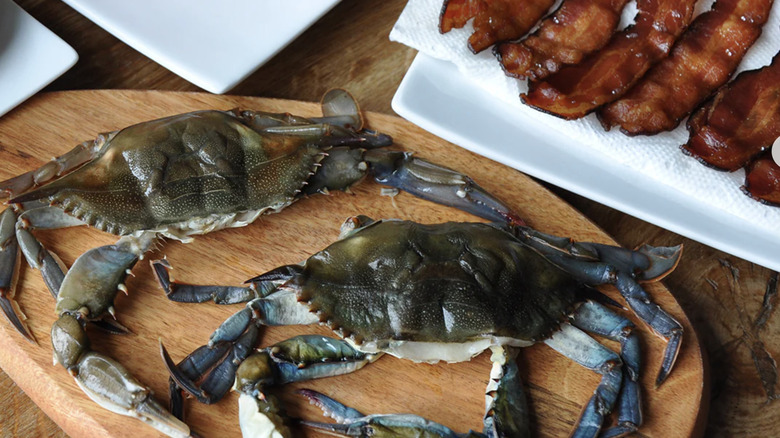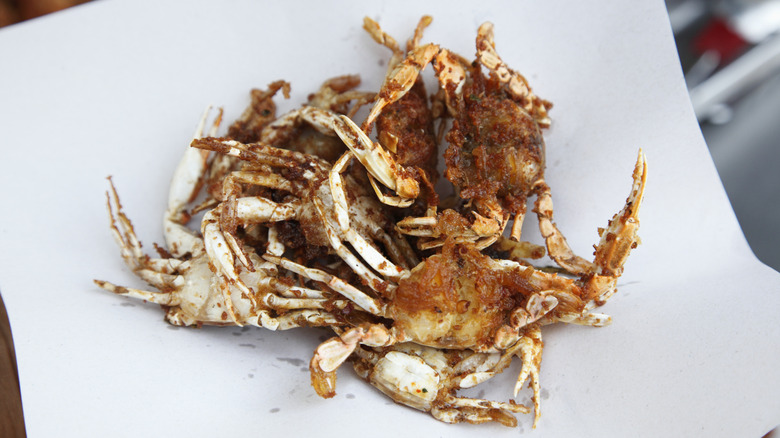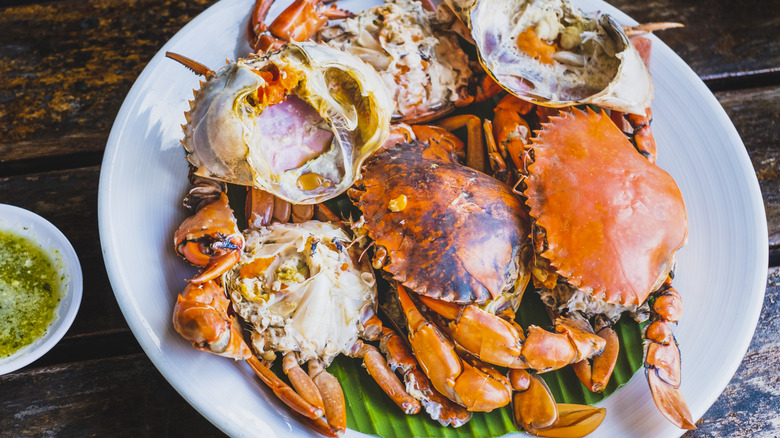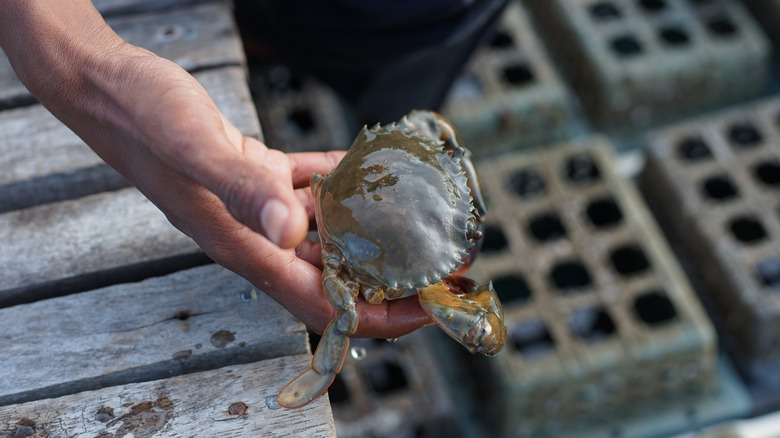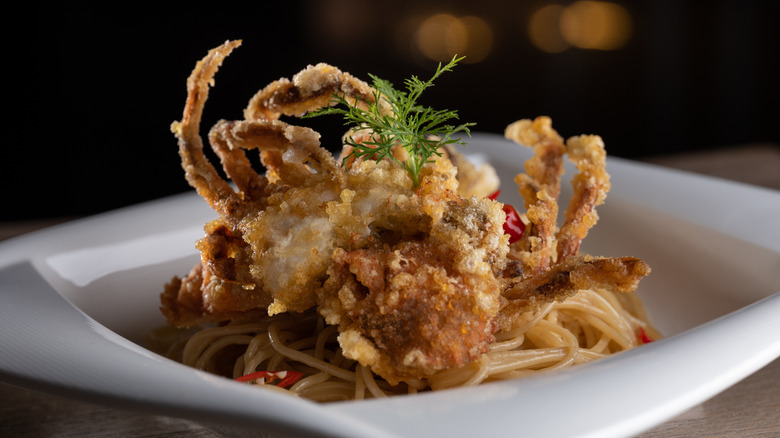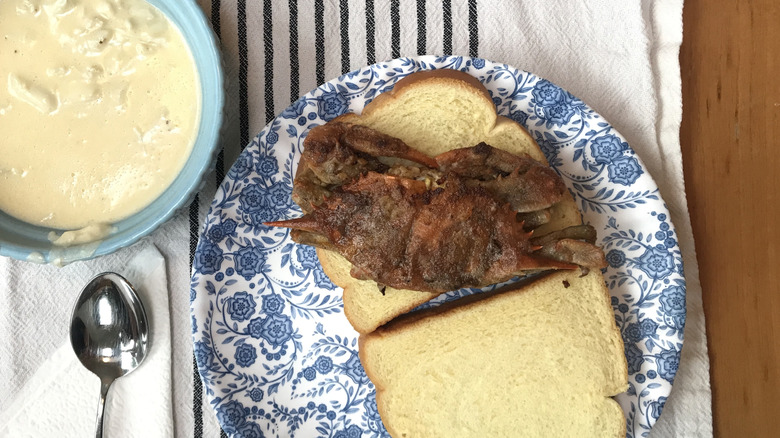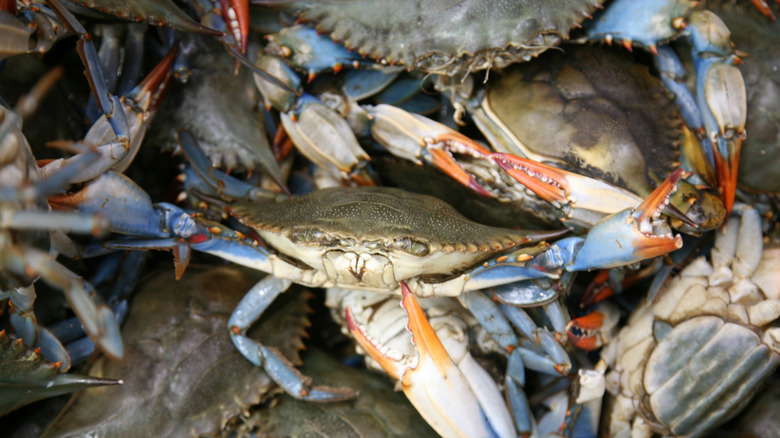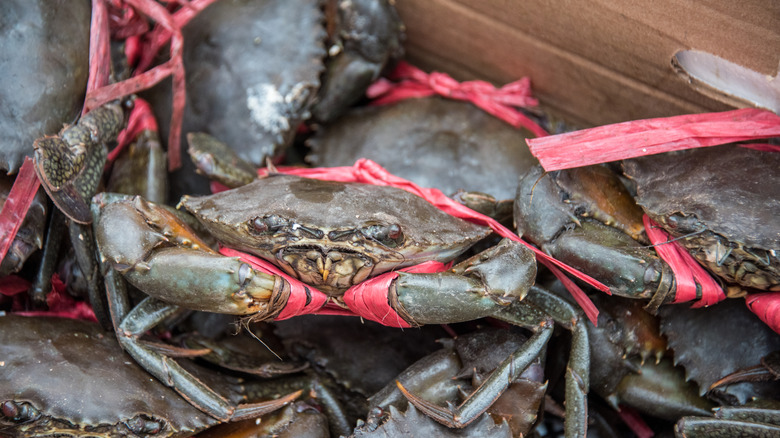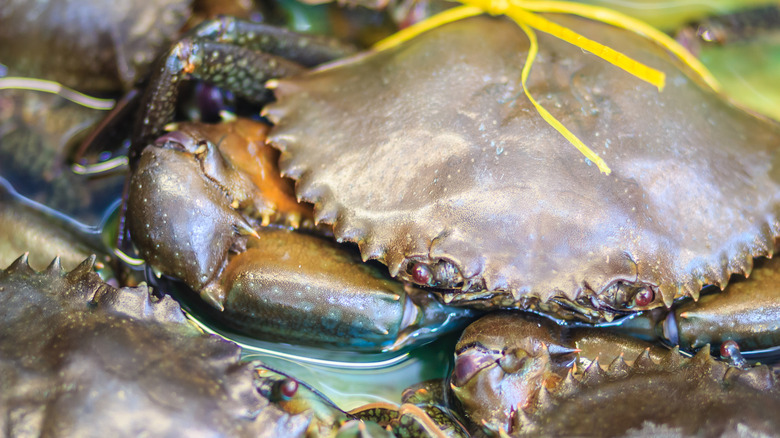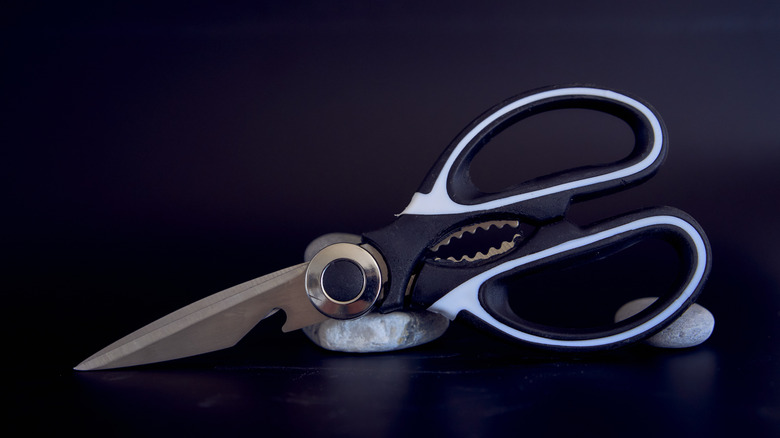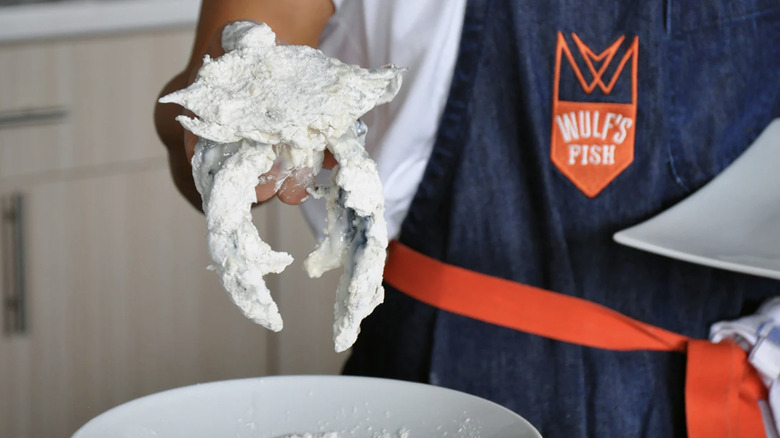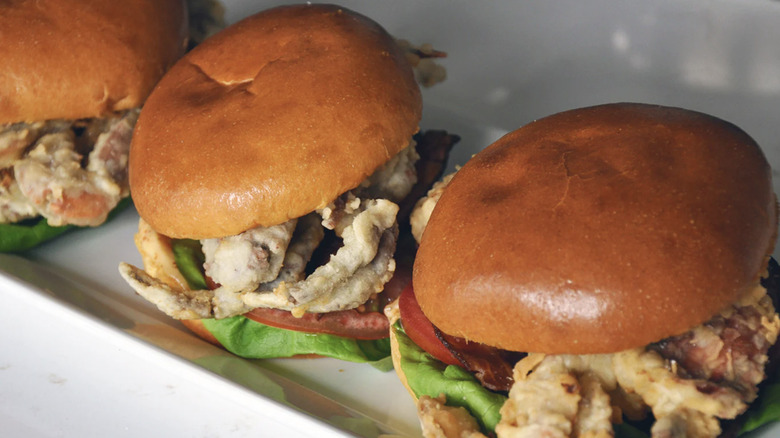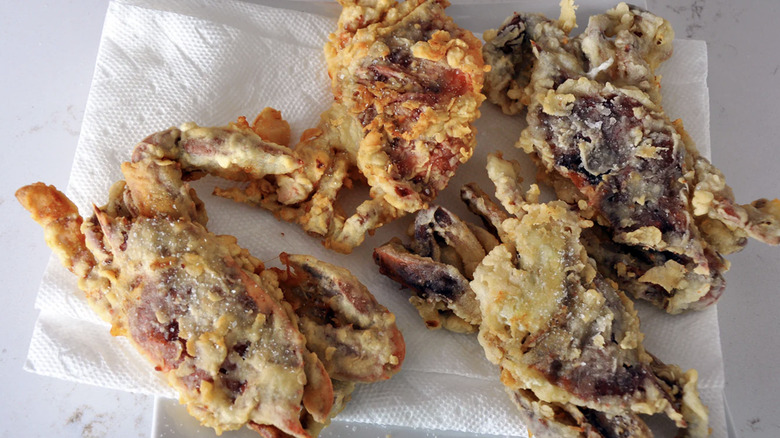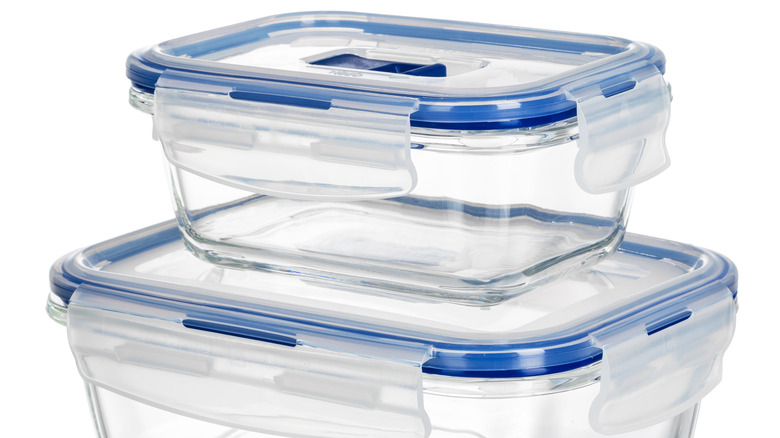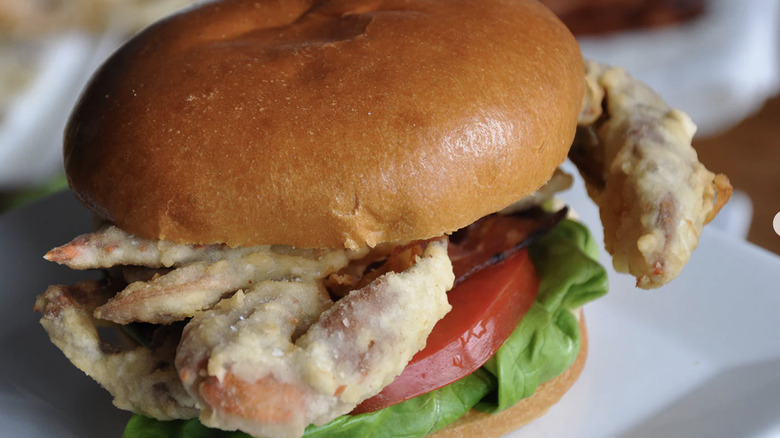A Beginner's Guide To Soft-Shell Crab
We may receive a commission on purchases made from links.
Human dietary preferences are nothing if not interesting, and that applies to our consumption of arthropods as much as anything else. For instance, Americans happily consume crabs while spiders gross us out. Even though the two are distantly related, crab is widely regarded as a delicacy, while spiders are distasteful to many in the Western world, though still eaten in Asia, South America, Australia, and Africa. And while it's only seasonal, spidery-looking soft-shell crab is an even bigger fan favorite around the globe.
Soft-shell crabs' uniqueness as an ingredient — as well as its seasonality and different cooking requirements — may make soft-shell crab a bit of a head-scratcher to home cooks, but it's worth learning to prepare them yourself. "Soft-shell crab is more than a dish, it's an experience," says Maricel Gentile, chef and author of "Maricel's Simply Asian Cookbook." Eating them, she adds, is "about honoring timing in nature, savoring a fleeting season, and embracing every bite without waste."
Not wasting is easier with soft-shell crab than other types, because you eat the entire thing. "What makes soft-shell so good is the fact that you're getting all that sweet crab flavor in a super convenient package," explains Dennis Littley of Ask Chef Dennis. "It's seasonal, it's versatile, and when it's done right, it's absolutely delicious." But how, exactly, do you go about choosing, cleaning, and cooking this delicacy? That's where this guide to soft-shell crab comes in.
What is soft-shell crab?
First and foremost, it's important to understand what soft-shell crab is so you can purchase the tastiest and highest-quality specimens. "Soft-shell crabs are crabs that have just molted their shell and are harvested before their new shell has calcified and hardened," says Andy McLeod, executive chef at Fleet Landing. "Because the shell is not hard, it makes it possible to eat the whole crab without having to pick the meat out."
Typically, says Joe Lasprogata, senior VP of product development and resident marine biologist at Samuels Seafood Company, "Soft-shell crab typically refers to the Atlantic blue crab [Callinectes sapidus] that has recently molted. When water temperatures reach around 55 degrees Fahrenheit, the crabs emerge from hibernation in the sand and begin to molt, marking the start of soft-shell season." This is an extremely fleeting stage in the crab's life cycle, he adds, when the crab is in a rare tender state and needs no cracking or picking, and it's an experience unto itself.
Interestingly, McLeod says, "The process of calcification starts immediately after molting and can happen in a matter of just a few hours, so the crabs are harvested moments after they molt." For that reason, they can sometimes be difficult to find, but are usually reliable when in season if you head to a good fishmonger.
How is soft-shell crab different from regular crab?
Many people looking for a guide to soft-shell crab and unfamiliar with the food assume it is a species of crab. However, soft-shell is not an actual species, but rather a stage in the crab's development. Crabs have exoskeletons, which are not flexible or capable of expansion. As such, Joe Lasprogata says, they must shed those hard exoskeletons in order to grow.
That said, a soft-shell crab has all the same parts that a regular crab does: carapace, claws, legs, eyes, mouth, gills, organs, and so on. Distinct characteristics will vary from species to species. It's also important to note that soft-shell crabs are not "babies," as crabs continue to molt throughout their lives — though they do molt far more often when young and growing quickly. This means you can get soft-shell crabs in a variety of different sizes, just as you can with regular hard-shell crabs.
Where does soft-shell crab come from and when can you get it?
"Soft-shell crabs are found primarily along the Atlantic and Gulf coasts, especially in states like Maryland, North Carolina, and Louisiana," says Allie Hagerty, daughter of a fishmonger and recipe developer at Seasoned and Salted. Virginia is another common state from which soft-shell crabs are sourced.
Like most gifts of the sea, there is a best season to buy your favorite shellfish, and soft-shell crabs are no exception. Typically, the season begins in the spring, around April, when water temperatures begin to rise and trigger molting. Indeed, says Desiree Antczak, senior sales account manager at Wulf's Fish, the appearance of soft-shell crabs is a sign of spring. Depending on the region, soft-shell crabs will remain available through the summer and into early fall. However, Antczak says, "Many wholesalers will stop carrying them at the height of the summer because they don't travel as well in the heat."
That's just in North America, though. "In the Philippines," Maricel Gentile says, "my Lola always reminded us of crab season around the lunar calendar, since molting crabs align with moon phases. I still feel that rhythm in my cooking." If you want a guide to soft-shell crab sourcing and timing in your particular area, it's a good idea to talk to someone at the seafood counter in your local grocery store or a dedicated fishmonger. Find out more about when they'll be available ahead of time and mark your calendar to check back.
What does soft-shell crab taste like?
The taste of a soft-shell crab is similar to regular crabs of the same species, but with a rich and buttery tenderness and a delicate flake to the meat. Also, like regular crab meat, soft-shells taste a bit tangy and sweetly briny, if a little less robust in flavor. But that flavor is what you're here for, says Allie Hagerty. For that reason, you should make sure not to overthink your prep, she says: "The goal is to let that sweet, briny flavor shine."
"What makes soft-shell crab so special is the texture: a gentle crunch outside, and sweet, briny meat inside," Maricel Gentile says. The crab is not completely without structure (or it would fall apart in the intermolt period), but becomes instead delicately crunchy, like a chewy chip. "It's a delicacy that's all about timing and tenderness."
Can you eat the entire soft-shell crab?
Any guide to soft-shell crab inevitably deals with the skeptical question: Can you really eat the entire crab? And the answer is yes, says Maricel Gentile. Minus the few bits that are removed during preparation, you can eat everything on the crab, "shell, claws, and all." Even better, because they are young and tasty, soft-shell crabs are usually high quality, saving you the trouble of figuring out how to use low-quality crab meat.
Soft-shell crabs, like other crabs, have both white and brown crab meat. However, since you traditionally cook soft-shell crabs whole, you needn't distinguish between the two — you'll get both in every crab, if not every bite. Another important distinction between mature crabs and their soft-shell cousins is that you don't need to undergo the painstaking process of removing the meat from the crab legs, which is annoying even in very large crabs.
Types of soft-shell crab
It's worth spending a moment to talk about what types are included in the "soft-shell crab" designation. Once again, this is not actually a species designation, but rather a life cycle stage right after molting. But typically, Desiree Antczak says, "All crabs molt, but when we talk about soft shell crabs in the U.S., we mean blue crabs (Callinectes sapidus)."
However, while blue crab is the main species caught and eaten in the United States, people enjoy many other types around the world, such as green crabs or Asian shore crabs, according to Maricel Gentile. Mud and mangrove crabs are other popular species to eat in their soft-shell stage, according to Allie Hagerty. Horseshoe and Mediterranean crabs may also be consumed in this way.
The other way to distinguish soft-shell crabs is by size. Indeed, there is even nomenclature for this: mediums, hotels, primes, jumbos, and whales, with mediums starting at 3.5 inches and every grade thereafter representing a jump of half an inch. How cute is that? As for which you should choose? "Size-wise, it depends on how you want to serve them," Dennis Littley says. "Medium ones are great for sandwiches or sliders, and the bigger ones are perfect for plating whole with a simple side."
How is soft-shell crab sold?
"Soft-shell crabs are sold live, 'fresh dressed' (which is dead but with the gills and face removed), or frozen," Desiree Antczak says. "All three options can be very good quality." The frozen options are especially useful if you want to stock up. But, Dennis Littley adds, "If you've got access to a good seafood market during the warmer months, it's worth grabbing them fresh while you can."
Unless you're buying frozen, getting soft-shell crabs takes some planning. You shouldn't plan to get them down at the dock or using a pot, for instance. Because the intermolting period – the time between when the shell comes off and the new shell begins to harden — is so short, purveyors often keep crabs that are ready to molt in tanks, then pull them out of the water as soon as they shed the shell. We're talking a matter of hours here, so if you want to be sure you have soft-shell crabs for a dinner party or another important event, make sure you call ahead and figure out the best option rather than popping off to a store and hoping for the best.
What should you look for when buying soft-shell crab?
When purchasing soft-shell crab, the type you want will guide what you look for. "Live crabs are best when purchasing soft-shell crabs to ensure freshness," Andy McLeod says. "They typically come packed in flat cardboard pallets and are stored between straw and wet newspaper to keep them from drying out. They should also be chilled." Take note of the smell. It should be clean and briny, smelling of the ocean. If you smell anything fishy or sour, steer clear. You should also check for plump, glistening, intact carapaces and avoid anything shriveled or deflated-looking.
If you don't want to deal with prepping them yourself, you can buy them pre-cleaned and already dead. If you do so, Allie Hagerty says, make sure to check the packaging date. "Fresh soft-shell crabs should be cooked within a day or two of purchase," she says, "and because you're eating the entire crab, sourcing matters. Look for local, sustainably caught crabs when possible." If crabs are not already pre-cleaned, you can ask a fishmonger to do it for you at the time of purchase.
Lastly, you have the frozen option. Depending on your options, you may find them at your local grocery store or you may need to go to a specialty shop. "If you're buying frozen," Maricel Gentile says, "make sure they're individually vacuum-sealed and have no freezer burn."
How do you prep soft-shell crab?
While you can use a basic guide to buying, preparing, and cooking crabs with most species, soft-shell crabs are a little different because they're so delicate. The long and short of it is, if you've never cleaned a soft-shell crab before, you're in for a bit of a shock: you have to prep them while they're still alive. "Crabs are prepared by trimming the front with scissors, rendering them completely immobile, then doing a quick cleaning to remove the apron and gills before cooking," Andy McLeod explains. Specifically, trimming the front means cutting straight across the face to remove the mouth and eyes.
If this seems cruel, know that removing the face in this way is supposed to kill the crab instantly, saving it from any pain further in the process, such as cooking it alive. So while it might seem a little barbaric, this is actually the most humane approach to cooking them. Kitchen shears and sharp knives will both work to make the process go smoothly. Just make sure they're not dull or blunted, which will make your job more difficult and also make it harder on the crab. The imarku 8 Inch Steel Chef Knife or All Purpose Heavy Duty iBayam Kitchen Scissors are both good options.
How to fry soft-shell crabs
There are, of course, many ways to prepare soft-shell crabs. Many of these rely on some form of frying, though, so it's a good idea to start there. Once you've cleaned your crab, Maricel Gentile says, pat it dry. "I like to keep it simple by lightly dredging them in seasoned cornstarch or flour, then pan-frying or deep-frying until golden." Tempura style also works for this, she says. "The goal is to keep the natural flavor front and center, with just enough crisp to highlight its softness." This method is the best way to ensure even crispiness around the entire shell, Andy McLeod adds.
According to Desiree Antczak, the frying part is easy as well if you have the right recipe. Simply heat an inch of oil in a shallow pan. Make sure to use a high-heat product that won't smoke, such as Pompeian 100% Grapeseed Oil. Heat to 350 degrees Fahrenheit, dredge your crabs, and gently drop them into the hot oil. Fry them for about 2 minutes, flipping at the 1-minute mark, then remove them from the oil using a tool such as Hotec Stainless Steel Kitchen Tongs or a set of three Spider Strainers. Rest them on a wire rack to drain, or put them on a paper towel-lined plate. Make sure to salt them while they're still hot.
Easy soft-shell crab recipes for beginners
No guide to soft-shell crab is complete without a starter list of recipes. "Traditionally, soft-shell crabs were sautéed and served with toast points," Joe Lasprogata says, "but nowadays, most people prefer to deep fry them. They're also excellent grilled or pan-seared, depending on your taste." Lemon and garlic go well as flavoring agents, he says.
"Personally," Dennis Littley says, "I love them in a po boy. Crusty bread, some remoulade, crisp lettuce, and you're good to go." Note that the po boy is also an amazing sandwich to top with coleslaw, which is a classic addition to fried seafood. If you want to dress them up a bit more, Littley says, try some brown butter with lemon and herbs. Or, says Desiree Antczak, you can make a fried soft-shell crab BLT. That's right: bacon AND crab. Nom nom.
Maricel Gentile loves soft-shell crab with calamansi soy dipping sauce, a nod to her Filipino roots. The combination of citrus and soy cuts through the richness of the crab beautifully, she says. "I also love them in a Vietnamese-style banh mi with pickled carrots and daikon, or Korean-style, brushed with gochujang and flash-fried," she adds. "For something comforting, I'll serve it on garlic rice with a fried egg, like a seafood silog." Allie Hagerty's go-to is a simple sandwich: crab, lemon aioli, and a few slices of heirloom tomato. Or, if you need some lighter fare, serve fried crabs over a summer salad.
Cooking precautions
Soft-shell crab is actually pretty easy to cook, but there are a few precautions of which you should take note. First, Desiree Antczak says, "Use extra caution when frying soft shell crabs because there are pockets of juiciness they can pop and splatter as they release liquid. Protect yourself by wearing long sleeves and using a splatter screen." Tools such as a U.S. Kitchen Supply Stainless Steel Splatter Guard can help, as can protective clothing like a Waterproof Rubber Vinyl 40 Inch Chef Apron or Rapicca 932 degrees Fahrenheit Heat Resistant BBQ Grill Gloves.
You should also take care to protect the crabs during cooking. Don't overcrowd them, which could cause them to stick together and cook unevenly. It could also bring down the temperature of the oil, leading to a subpar result. Overall, Dennis Littley says, "The main thing is not to overcook them, so high heat and short cooking time is key. However you do it, the goal is to let that natural sweetness of the crab shine through." If they're burnt to a crisp, that won't happen.
Safe storage before and after cooking
How you should store soft-shell crabs depends on their state. "If buying frozen soft-shell crabs, keep them frozen until the day you want to cook them," Desiree Antczak advises. "They thaw quickly because they are not dense. If fresh, clean and cook them within 24 hours of purchase." Ideally, you should keep them very cold so that they're sleepy and don't move around much, Andy McLeod says. "I try to take them out of storage just before preparing."
The good news, Antczak adds, is that soft-shell crabs freeze quite well. If you're enterprising, you can go buy them when they're fresh, then stock your freezer with raw crabs to enjoy them whenever you like. To do this, Dennis Littley says, "Just make sure they're cleaned first, then wrap them tightly to avoid freezer burn."
While soft-shell crab becomes rubbery when reheated, you can keep and reheat them for a day or two after cooking. Just make sure to put them in an airtight container, McLeod says. Amazon Basics Leak-Proof Glass Food Storage Containers are a good bet.
Nutritional information
While a soft-shell crab can vary in size, and, therefore, its exact caloric amount is hard to pin down. A typical specimen of blue crab is about 80 calories. Measured another way, 3 ounces of soft-shell crab contains about 70 calories, but in that pretty minimal package lurks a protein powerhouse: about 18% of your recommended daily value (DV) of protein per crab, not to mention 32% of your recommended DV of omega-3 fatty acids.
While soft-shell crabs aren't the lowest in sodium (15% DV) and cholesterol (27% DV), they do bring lots of micronutrients to the table, including calcium, iron, and potassium. Beyond the basic advice to watch your intake of fried foods in any form, they're a perfect — and perfectly delicious — way to get more seafood into your diet.
